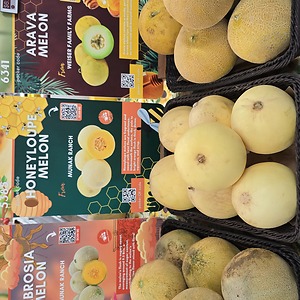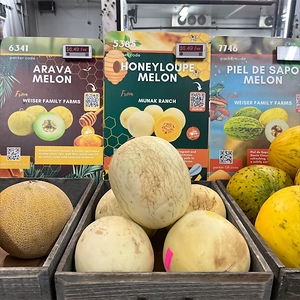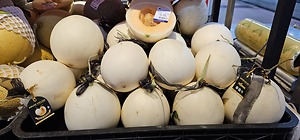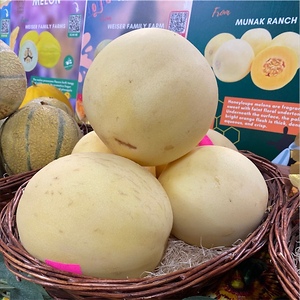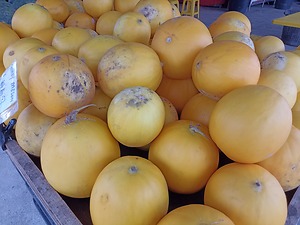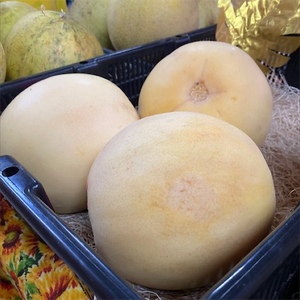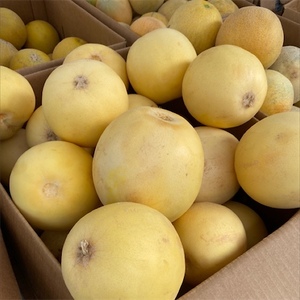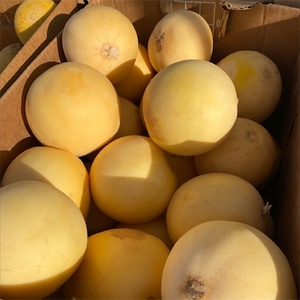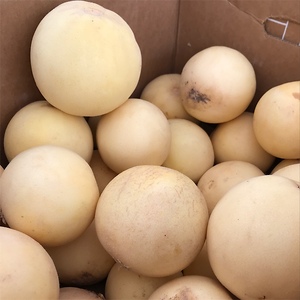


Honeyloupe Melons
Estimated Inventory, ea : 6.00
This item was last sold on : 07/31/25
Description/Taste
Honeyloupe melons are small to medium, oval fruits averaging 14 to 15 centimeters in diameter. The hard rind transitions from pale green to golden yellow-orange with maturity and remains firm and smooth, similar in consistency to a honeydew melon. Underneath the surface, the pale to bright orange flesh is thick, dense, aqueous, and crisp. There is also a central cavity filled with pockets of membranes encasing many small, tan seeds. Honeyloupe melons are fragrant and sweet with faint floral undertones.
Seasons/Availability
Honeyloupe melons are available in the summer through early fall.
Current Facts
Honeyloupe melons, botanically classified as Cucumis melo, are a hybrid variety belonging to the Cucurbitaceae family. The variety is a multi-generational cross between the honey ball melon, honeydew, and PMR45 muskmelon, and was initially developed to acquire the best characteristics of each parent. Honeyloupe melons were also created for both commercial and consumer markets, favored by growers and home gardeners for its resistance to disease, sweet flavor, and smooth, soft consistency.
Nutritional Value
Honeyloupe melons are an excellent source of vitamin A, which works as an antioxidant to help protect organ functioning and improve skin clarity. The sweet fruits are also a good source of vitamin C, which helps protect the immune system and contain vitamin B6, fiber, and potassium.
Applications
Honeyloupe melons are best suited for uncooked, savory and sweet preparations. The flesh can be pureed into cold soups and sauces, or it can be sliced and tossed into green and fruit salads. Honeyloupe melons can also be blended into smoothies, cocktails, and sorbets, chopped into salsas, or used as a flavoring in puddings and pastry fillings. The sweet flavor of the flesh compliments salted meats and strong cheeses on charcuterie plates, and the variety is frequently used as a topping for sweet breakfast items such as waffles, yogurt, and oatmeal. Honeyloupe melons pair well with cheeses such as feta, goat, and blue, arugula, basil, mint, pistachios, balsamic vinegar, and cured pork. It is recommended to store whole Honeyloupe melons at room temperature, and once cut, the slices should be stored in a sealed container in the refrigerator for up to three days.
Ethnic/Cultural Info
Honeyloupe melons were developed for warm, dry climates and grow well in the San Joaquin and Sacramento Valley regions of California. The Sacramento Valley is home to over one million acres of agricultural farmland, and the city of Sacramento even branded itself as the “farm-to-fork capital” of the United States in 2012. Many Sacramento-based restaurants receive multiple shipments of fresh, local produce per week and center their menus around the seasonal offerings. Honeyloupe melons are a popular dessert melon in the Sacramento food scene. The sweet melons are blended into shaved ice, chilled into gazpacho, or used as a topping over ice cream. Beyond the city’s rebranding, there is also a farm-to-fork food festival in Sacramento that highlights local farms, restaurants, and chefs, drawing thousands of visitors each year.
Geography/History
Honeyloupe melons were developed in the late 20th century by Frank W. Zink at the Agricultural Experiment Station at the University of California, Berkley. The sweet variety was explicitly bred to exhibit a vibrant coral-hued flesh and increase resistance to the common muskmelon disease, Verticillium wilt. Once the variety was released to commercial and home markets, the melons saw success throughout California and in other select regions of the United States. The Honeyloupe melons featured in the photograph above were grown at Munak Ranch, a farm located in the Upper Salinas Valley near Paso Robles, California.
Featured Restaurants
Restaurants currently purchasing this product as an ingredient for their menu.
| A & M catering | San Diego CA | 206-802-8320 |
| Searcher Sportfishing | San Diego CA | 619-861-4640 |
| Mission Pacific | Oceanside CA | 760-450-7864 |
| LANA | Solana Beach CA | 602-758-2596 |
| Beaumont's | San Diego CA | 858-459-0474 |
| New Wave Bagel | San Diego CA | 415-533-4525 |
| The Santaluz Club Inc - Banquet | San Diego CA | 858-759-3150 |
| Lodge at Torrey Pines Main | San Diego CA | 858-453-4420 |
| Siamo Napoli | San Diego CA | 619-300-4810 |
| Seasoned Catering and Events | San Diego CA | 619-246-4909 |
| Ju-Ichi | San Diego CA | 619-800-2203 |
| Fox Point Farms | Encinitas CA | 619-892-0553 |
| Little Lion | San Diego CA | 619-519-4079 |
| Institutes of Health LLC | San Diego CA | 800-270-5016 |
| Kettner Exchange | San Diego CA | 909-915-9877 |
| Cape Rey Carlsbad, a Hilton Resort | Carlsbad CA | 760-602-0800 |
| Farmer and The Seahorse | San Diego CA | 619-302-3682 |
| Lucien | La Jolla CA | 707-387-7163 |
| Catania La Jolla | La Jolla CA | 619-884-5350 |
| Golden Door | San Marcos CA | 760-761-4142 |
| Gaylord Pacific Resort | Chula Vista CA | 619-310-9800 |
| Cal A Vie | Vista CA | 760-945-2055 |
| Sushi Gaga | San Diego CA | 619-808-1556 |
| Inn at Rancho Santa Fe | Rancho Santa Fe CA | 858-381-8289 |
| Lauberge Del Mar | Del Mar CA | 858-259-1515 |
Recipe Ideas
Recipes that include Honeyloupe Melons. One
| David Lebovitz |
|
Frozen Melon Margaritas |



